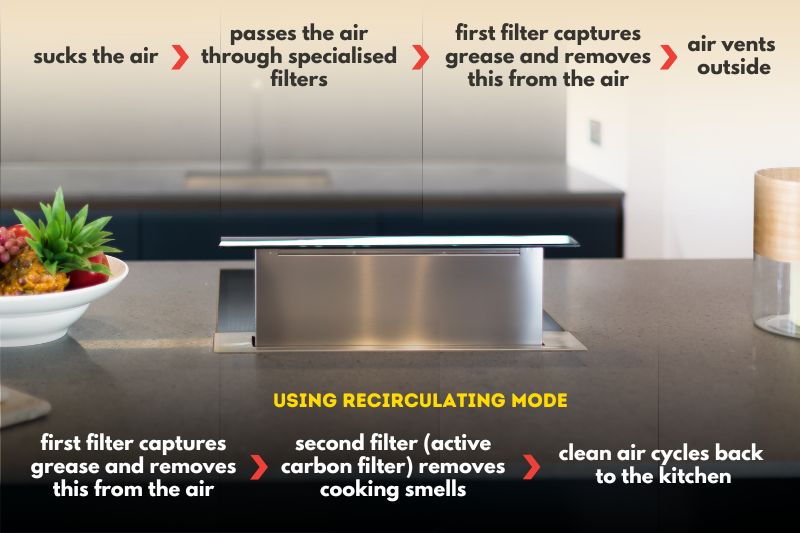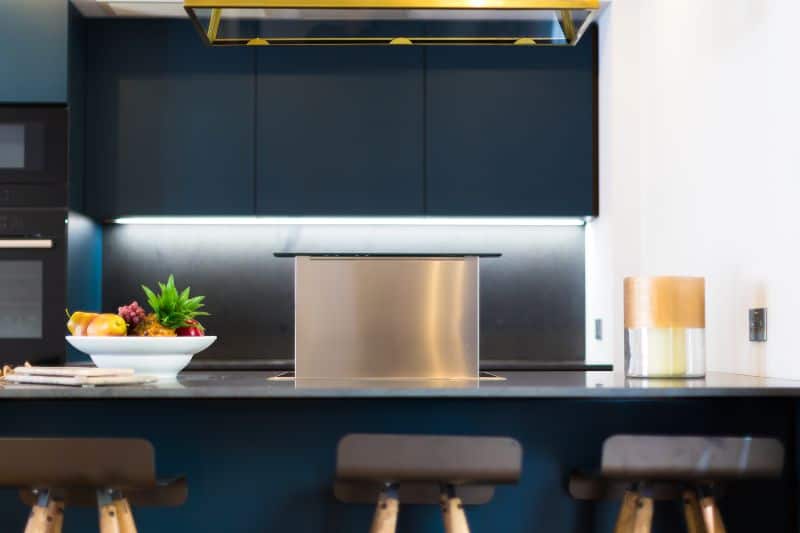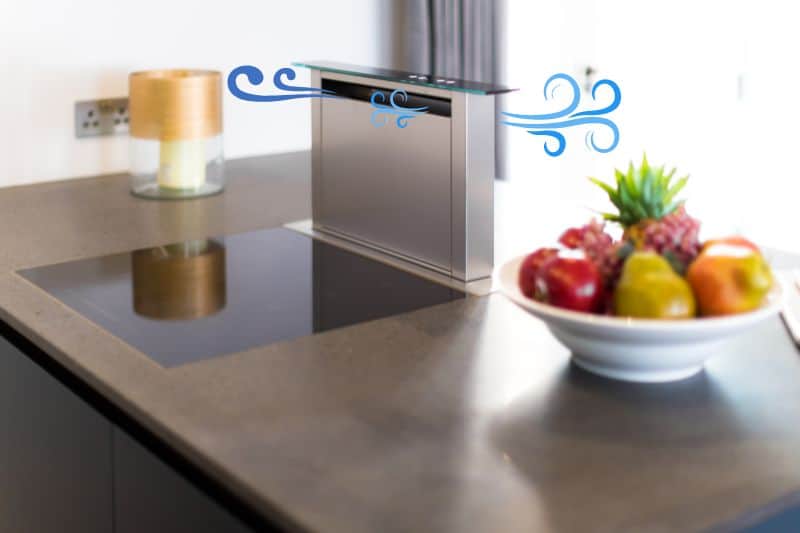Downdraft extractors are the perfect solution for anyone wanting a modern kitchen.
These extractors are fitted into the counter behind your stove, rather than above it. This means they are ideal for hobs on kitchen islands and remove unnecessary bulk from kitchens.
Say goodbye to ugly overhead cooker hoods, and hello to your sleek new kitchen design solution!
But where do downdraft extractors vent to? And how do these nifty extractor fans actually work to remove smells and grease from the air?
How Does a Downdraft Cooker Hood Work?

Downdraft extractors fit into the countertop directly behind your kitchen hob. They actively suck the air directly from your food as you cook.
This includes all steam, grease, and smells, not allowing any of the air to rise into the room and circulate around your home.
Once they have sucked up the air, downdraft extractors pass the air through specialised filters.
The first filter is designed to capture grease and remove this from the air. The air then vents outside to be eliminated.
Alternatively, downdraft extractors can be used in recirculating mode, whereby the air that is filtered is cycled back into your kitchen.
If using the downdraft extractor in the recirculating mode, air passes through an additional active carbon filter.
These carbon filters are made from charcoal, which has outstanding odour-absorbing properties.
Therefore, as the air passes through this second filter all the cooking smells are removed. The air is clean and fresh and doesn’t smell like cooking whatsoever.
Does a Kitchen Extractor Need to Vent Outside?

When your kitchen extractor fan sucks out air from your kitchen, it needs to vent somewhere.
Extraction hoods typically do vent air outside, hence the term “extraction”. They literally extract air from your kitchen and deposit it (and all the steam, grease, and smells that come with it) outside your home.
This leaves the air in your home fresh and clean.
However, as just established, extractors don’t need to vent outside. They can pump the air back into your kitchen instead!
Therefore, these fans are more often called “downdraft recirculation hoods” as opposed to “downdraft extractors”.
Still, the latter is often used interchangeably to describe both types of venting methods. Besides, most models can be configured to work in whichever way you prefer.
You might be concerned that recircling cooking air back into your home sounds disgusting. However, extractor fans that use this mechanism have filters as discussed above.
The first removes the grease, and the second removes all cooking odours. As such, kitchen extractor fans don’t need to vent outside.
But if pumping the air back into your home, ensure there is a carbon filter so you’re not breathing in unpleasant smells.
How Effective Are Downdraft Extractors?
You might be wondering how effective downdraft extractors are compared to their overhead hooded counterparts.
The answer is that downdraft extractors are slightly less effective. This is because stream naturally rises, making it easier for overhead extractors to do the work.
On the other hand, downdraft extractors need to put in a little more effort to capture the rising air.
Therefore, downdraft extractors tend to be 80-90% as effective as regular overhead hooded extractors.
For home cooks, this difference is negligible, and so either type of extractor is a suitable option. However, people cooking in commercial kitchens might benefit from a traditional extractor fan.
Moreover, downdraft extractor fans only extend to around 20cm to 40cm above the kitchen countertop. Therefore, they can only extract steam and air from pots and pans lower than this level.
If you have a large family and regularly use taller cookware with a larger capacity, you might struggle with a downdraft extractor. In these cases, overhead fans might work best.

Hannah is a freelance content writer and self-proclaimed foodie. When Hannah isn’t sitting tapping at her laptop, you’ll probably find her in the kitchen. As an ex-chalet host, she’s used to cooking four-course meals for 10+ people and loves feeding friends and family whenever possible.

